Understanding the Value of Diamonds: Key Insights
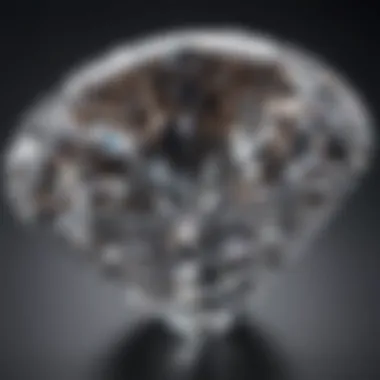
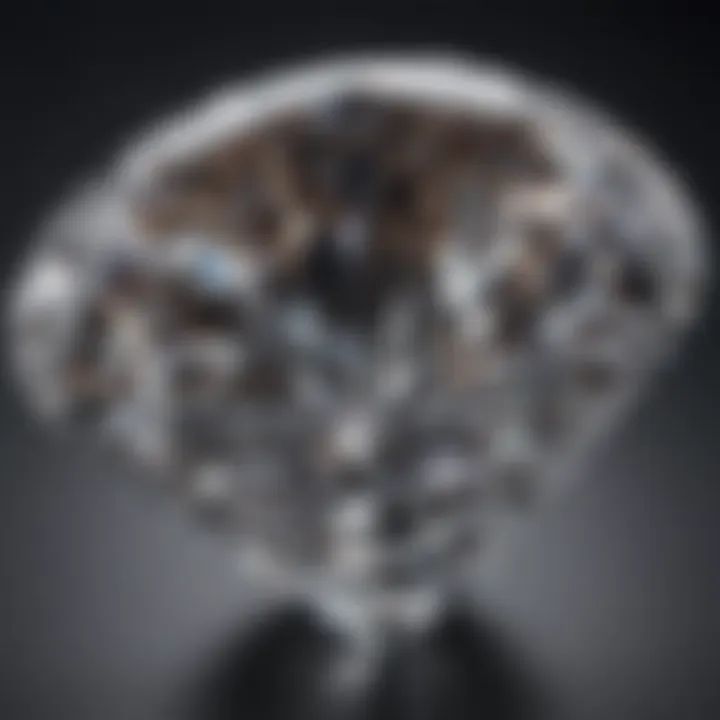
Intro
When it comes to precious stones, few captivate the human imagination quite like diamonds. Their brilliance and durability have rendered them symbols of power, love, and even a few legends. But what really gives a diamond value? There’s a labyrinth of criteria behind each sparkling gem, and many layers to understand before you can confidently navigate a jewelry store or investment opportunity. This investigation aims to peel back those layers, helping you grasp how diamonds come to be priced and valued.
Gemstone Overview
Definition of Gemstones
Gemstones are naturally occurring minerals, rocks, or organic materials that have been cut and polished for use in jewelry and decor. They are esteemed not just for their aesthetics but also for their rarity and perceived value. While diamonds are perhaps the most famous, gemstones range widely from amethyst to sapphire—each with its own story, characteristics, and value metrics.
Classification of Gemstones
Gemstones can be divided into two broad categories: precious and semi-precious. Although these terms might seem cut and dry, their definitions have evolved over time.
- Precious Gemstones: This group includes diamonds, rubies, sapphires, and emeralds. These stones generally score high on the scale of beauty, rarity, and toughness, which elevates their market value.
- Semi-Precious Gemstones: This catch-all term generally includes a variety of other stones such as garnet, tourmaline, and opal. While still beautiful and valuable, they do not typically command the same high prices as precious stones.
A diamond, for instance, not only falls under the precious category but is also the hardest known natural material, making it a fascinating case study in value assessment.
Historical Significance
Origins of Gemstone Use
The history of gemstones stretches back to ancient civilizations. The allure of gemstones can be traced as far as prehistoric times when our ancestors adorned themselves not only for aesthetic pleasure but also for spiritual or protective reasons. In many cultures, gemstones were considered talismans or amulets, offering safety and good fortune.
Cultural Insights: Gemstones in Ancient Civilizations
In Ancient Egypt, for example, the use of gemstones was both decorative and ritualistic. They prized emeralds and lapis lazuli. Meanwhile, ancient Greeks believed that diamonds were the tears of the gods, a notion that highlights the deep-seated cultural significance attributed to these stones. Even today, in various segments of society, diamonds are seen as symbols of wealth and status, thanks to a combination of marketing, history, and their striking appearance.
"A diamond is forever." – a phrase that has become almost synonymous with love and commitment, encapsulating what diamonds mean to thousands of couples across the globe.
The multifaceted nature of how diamonds are perceived, from tools of divination in the past to modern-day engagement rings, exemplifies their enduring appeal. The lessons learned from historical practices and beliefs provide invaluable insights for today’s collectors and enthusiasts.
As we delve deeper into understanding diamond value, one must appreciate not only the stone’s physical characteristics but also its journey—from mine to market. The interplay of history, culture, and scientific assessment contributes richly to the ultimate price you might pay for a diamond.
Prelude to Diamond Valuation
When it comes to diamonds, understanding their value is not just about a price tag. It's a complex interplay of various elements that define how we perceive worth in these stunning gemstones. From their aesthetic appeal to their cultural significance, every facet plays a crucial role. This section aims to break down the essentials of diamond valuation, shedding light on why it matters not only to buyers but also to collectors, investors, and jewelry designers alike.
The Significance of Value in Diamonds
The value of diamonds transcends mere economics; it embodies a tapestry of emotional, social, and historical dimensions. For many, a diamond represents a rite of passage, often symbolizing love and commitment. However, for those on the business side, understanding how value is determined can be a game changer. - The right knowledge can turn a passion for diamonds into a strategic financial decision.
- Emotional Value: Many individuals attach personal significance to diamonds, making family heirlooms invaluable, irrespective of market prices.
- Market Dynamics: Prices fluctuate based on global supply and demand, driven by shifting trends in consumer preferences.
- Cultural Importance: In various cultures, diamonds signify status and wealth, growing their desirability further.
By grasping these perspectives, one can appreciate not just the financial but also the intrinsic value that diamonds hold in different contexts. This understanding aids in making informed choices whether one is purchasing a jewel for an engagement ring or considering investment opportunities.
Cultural Perspectives on Diamond Worth
Cultural perspectives add a rich layer to the narrative of diamond valuation. Diamonds have been revered across many societies, often carrying symbolic meanings that extend far beyond their visual beauty.
- Historical Context: In many cultures, diamonds were once seen as talismans, believed to bestow protection and wisdom on their bearers. Even today, in places like India and among the Western world, these stones often play a pivotal role in expressing socio-economic status.
- Ceremonial Relevance: Events like weddings are often marked by diamond-studded attire, which elevates the stone’s importance in society. They represent not only luxury but enduring love and commitment.
- Modern Trends: Today, there's a rising interest in ethical diamonds, reshaping how people align their values with their purchases. This cultural shift emphasizes the ethics of sourcing, reflecting broader social consciousness.
In summary, diamonds are worth is not just a matter of market conditions; it's interwoven with storytelling, beliefs, and ethical considerations that shape consumer behavior and investment decisions.
The Four Cs of Diamond Value
The concept of the Four Cs—Cut, Color, Clarity, and Carat weight—stands at the very core of diamond valuation. Each of these elements plays a pivotal role, influencing not just the market price but also the desirability and emotional appeal of diamonds. For anyone looking to navigate the intricate landscape of diamond buying, understanding these four facets is paramount.
Cut: The Art of Precision
The cut of a diamond is often seen as its most important characteristic. It's not merely about shape; it represents the craftsmanship involved in shaping a raw stone into a sparkling gem. The precision of the cut affects how light enters and reflects within the diamond, creating brilliance and fire. For instance, an expertly cut round diamond can outperform a poorly cut one, despite having similar carat weight.
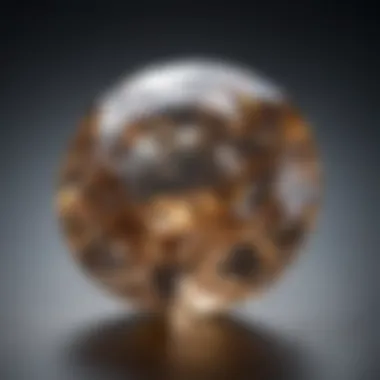
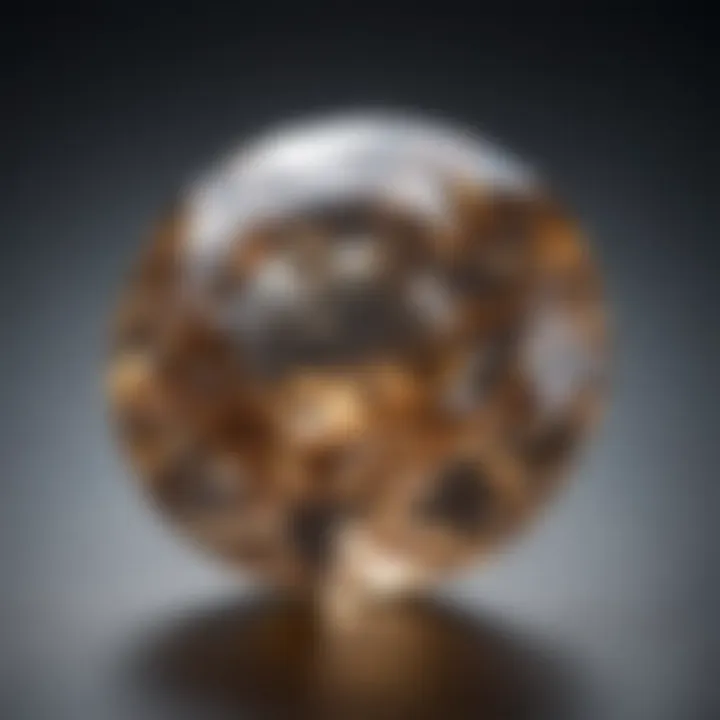
A well-cut diamond is the one that seems to glow from within. When cut poorly, even the highest quality stones can appear dull and lifeless. Cut grades generally range from Excellent to Poor. Knowing how to evaluate a diamond’s cut can make a significant difference in both appearance and value.
Color: The Spectrum of Diamonds
Color in diamonds ranges from completely colorless to various shades of yellow or brown. However, when discussing quality, it’s the absence of color that is deemed most valuable. The Gemological Institute of America (GIA) uses an alphabetical scale from D (colorless) to Z (light yellow) to grade diamonds. A color grade can influence the diamond's value tremendously.
While some people prefer diamonds with more warmth in their color, the general market trends lean towards favoring the colorless stones. Fancy-colored diamonds, such as pink or blue, break from this norm and can command incredibly high prices due to their rarity.
Clarity: Evaluating Imperfections
Clarity refers to the presence of inclusions and blemishes in a diamond. These imperfections can be natural, often arising during the diamond formation process. The GIA clarity scale ranges from Flawless to Included. A flawless diamond exhibits no internal or external imperfections under 10x magnification, making it exceptionally rare.
Many buyers might think that a slightly flawed stone is inferior, but in some instances, these imperfections add character. It's often said that a diamond's story can be found in its flaws. Being familiar with clarity grades can help a buyer appreciate a diamond's overall beauty and value, irrespective of minor imperfections.
Carat Weight: More than Just Size
Carat weight often takes center stage in the eyes of many buyers, but it's essential to understand its context. While larger diamonds are generally more expensive, the relationship between carat weight and price is not linear. Two diamonds of the same carat weight can have vastly different values due to differences in the cut, color, and clarity.
Moreover, the term carat derives from the carob seeds that were historically used as a balance scale to weigh gemstones. Today, one carat equals 200 milligrams, and sizes can be visualized more effectively when one considers the diamond's proportions as well. Buyers must be wary of focusing solely on carat when assessing value, as it is the combination of all Four Cs that truly determines a diamond's worth.
Market Dynamics Influencing Price
Understanding the dynamics that shape the price of diamonds is pivotal for anyone invested in their beauty and value. The interplay between various market forces—supply, demand, economic indicators, and key industry players—creates a landscape that can be both lucrative and volatile. This section highlights crucial aspects that contribute to the valuation of diamonds, emphasizing the importance of being aware of these market dynamics for enthusiasts, collectors, and investors alike.
Supply and Demand Factors
The basic economic principles of supply and demand reign supreme when it comes to diamond pricing. When demand is high and the supply is limited, prices tend to soar. Conversely, if there's an oversupply, prices may dwindle—akin to a tide that ebbs and flows.
One key element in the supply chain is the geological scarcity of diamonds themselves. Not every corner of the world produces these gems, resulting in regional disparities in availability. Areas like Botswana and Russia often dominate supply but are not immune to fluctuations that emerge from political or environmental issues.
Market demand also plays a crucial role. Cultural significance—particularly in certain ceremonies or milestones—fuels demand for diamonds. When economic conditions are favorable, more people may invest in diamonds, tying into their status-symbol appeal. A surge in consumer interest in ethical or lab-grown alternatives has also begun to impact traditional diamond sales, shifting the balance of demand.
Economic Indicators and Their Effects
Economic indicators are like the weather forecast for the diamond market—sometimes sunny, sometimes stormy. Factors such as unemployment rates, interest rates, and consumer spending patterns have a direct influence on luxury purchases, including diamonds. When the economy is booming, folks feel more inclined to splurge on high-ticket items. However, in times of recession or uncertainty, spending on luxury goods often declines, affecting diamond prices negatively.
Furthermore, inflation is another hefty player in the diamond economy. When inflation rises, the cost of living goes up, often leaving consumers with less discretionary income for luxuries, including jewelry. Additionally, fluctuating currencies can impact the cost of imported diamonds, emphasizing the need for investors to keep an eye on broader economic trends and how they influence consumer behavior.
Influence of Diamond Mining Companies
The mining companies that extract diamonds wield significant influence over market dynamics. Major players, such as De Beers or Alrosa, can control the supply chain, adjusting how much diamond inventory is released into the market. A tight grip on supply often translates to increased prices.
These companies also engage in practices such as stockpiling—holding back diamonds during times of lower demand to prevent a price crash. Their marketing strategies often connect diamonds with luxury and status, further bolstering consumer desire and perceived value.
Additionally, ethical concerns about sourcing, especially relating to conflict diamonds, have led some companies to embrace more transparent and responsible practices. This shift has influenced consumer choices and preferences, adding another layer of complexity to the diamond market.
The market dynamics of diamonds are multifaceted and often interwoven, requiring astute understanding from buyers and sellers alike.
In essence, navigating the diamond market necessitates a keen awareness of these varying factors. Each element—from the fundamental laws of supply and demand to the overarching economic landscape and the strategies employed by mining companies—contributes to the ever-evolving narrative of diamond pricing.
Historical Context of Diamond Prices
Understanding the historical context of diamond prices is crucial for anyone interested in the world of gemstones. The price of diamonds is not merely a reflection of the Four Cs or market dynamics. It has been shaped by social movements, economic shifts, and significant events throughout history. By examining past price trends and key occurrences, one can gain insights that might help navigate today's diamond market more effectively.
Price Trends Over the Decades
Throughout past decades, the diamond market has experienced various price fluctuations. These trends often mirror broader economic conditions, societal values, and shifting tastes among consumers. In the 20th century, particularly post-World War II, there was a notable spike in diamond prices alongside rising consumer confidence and an increase in disposable income. Couples began favoring diamond engagement rings more than ever, partly due to successful advertising campaigns from companies like De Beers in the 1930s and 1940s. Their famous slogan, "A diamond is forever," successfully positioned diamonds as a necessary symbol of love and commitment.
As the decades progressed, prices became influenced by more than just demand. Events such as changes in mine output, geopolitical factors, and emerging markets contributed to significant shifts. For example, the discovery of large diamond deposits in Siberia during the 1970s resulted in decreased prices due to oversupply. However, the late 1990s and early 2000s witnessed a resurgence in prices as new markets in Asia began to emerge, leading to a renewed demand for diamonds.
Recent years have shown a more complex picture. Despite some fluctuations, prices have generally remained stable. The advent of lab-grown diamonds has added a new twist to the game, reshaping consumer perceptions and potentially impacting mining diamond prices as buyers weigh environmental considerations and price difference.
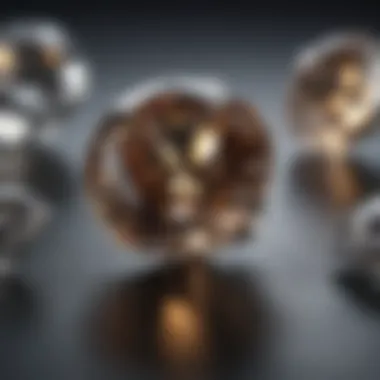
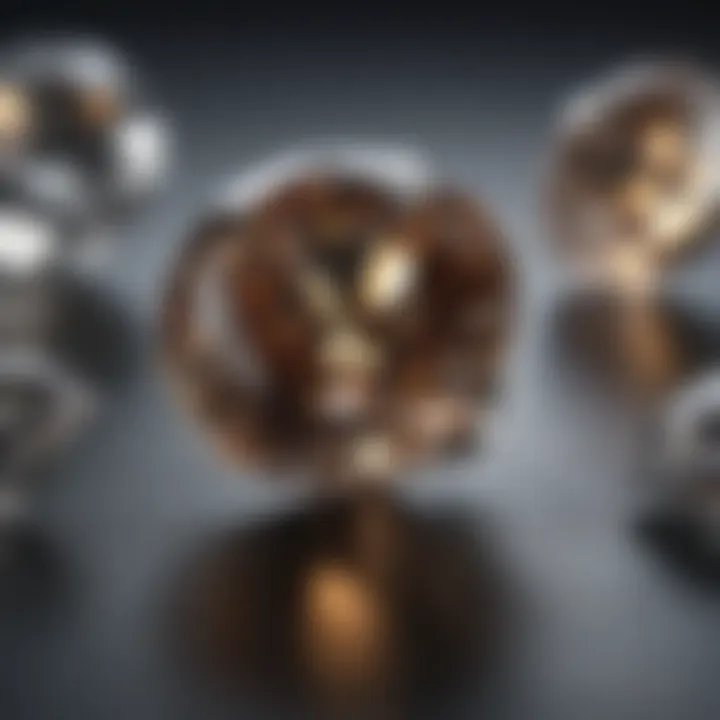
Key Events that Impacted the Market
A handful of landmark events have historically impacted diamond prices and market sentiment significantly. Understanding these events can shed light on current dynamics and consumer behavior.
- The De Beers Monopoly (Early 20th Century): De Beers controlled a large portion of the diamond trade and maintained artificially high prices through a combination of strategic marketing and stockpiling.
- Kimberley Process (2003): Established to prevent conflict diamonds from entering the mainstream market, this initiative highlighted ethical sourcing, which has conducted changes in consumer preferences towards ethically sourced diamonds.
- Global Recession (2008): The financial downturn led to decreased consumer spending, affecting diamond prices adversely. Many buyers opted for alternative gemstones or delayed purchases completely.
- Rise of Lab-Grown Diamonds (2010s): As technology improved, lab-grown diamonds became more accessible and created a shift in consumer enthusiasm. They offer a more affordable option and appeal to those concerned with the environmental and ethical implications of natural diamond mining.
These key events not only shaped the market landscape but also reflected evolving consumer attitudes and economic climates. Understanding these influences is essential for today’s diamond enthusiasts, collectors, and investors, allowing them to better comprehend the forces driving the industry.
"Diamonds have always been more than mere stones; they are dimensions of our cultural evolution, reflecting economic, ethical, and aesthetic values across time."
By analyzing the historical context of diamond prices, individuals can cultivate a deeper appreciation for these gems. It empowers buyers to make informed decisions, whether for personal purchases or investment opportunities.
Ethical Considerations in Diamond Valuation
The conversation surrounding diamonds has evolved significatly in recent years, not just from a valuation perspective, but also from an ethical one. As consumers become more aware of the origins of the products they purchase, it’s crucial to understand how ethical considerations impact the diamond market. Ethical values are not just about personal integrity or moral compass but also influence market trends and create a demand for responsibly sourced stones. This section digs deep into why ethical considerations matter in the valuation of diamonds and how they resonate with many collectors and buyers.
Conflict Diamonds and Their Impact
Conflict diamonds, often referred to as blood diamonds, are stones mined in war zones and sold to finance armed conflict against governments. The implications of this trade are dire, as profits are typically used to fuel violence, oppression, and human rights abuses. In the late 1990s and early 2000s, awareness around conflict diamonds surged, prompting international measures to curb their sale, such as the Kimberley Process Certification Scheme. Though this initiative aimed to ensure that diamonds sold globally were conflict-free, the effectiveness of such certification has come under scrutiny.
Some argue that while the Kimberley Process marks a step in the right direction, it is not foolproof. Issues persist with enforcement and a lack of transparency, allowing potentially unethical diamonds to slip through the cracks. Moreover, the mere existence of conflict diamonds alters perceptions of diamond value. A diamond sourced from a conflict zone tends to carry significantly less value in the eyes of conscious consumers. Consequently, the diamond industry must navigate these murky waters, or risk losing credibility—a prospect that could have far-reaching effects on their market as a whole.
"Awareness is the first step towards accountability; consumers must demand transparency in diamond sourcing."
Certification and Responsible Sourcing
Moving forward, the concept of certification has become paramount in establishing the legitimacy of a diamond. Organizations like the Responsible Jewelry Council and others are stepping in to endorse diamonds that are ethically sourced. Such programs evaluate not just the mining practices, but also consider the treatment of workers and environmental impacts. A diamond with a certified origin possesses a story that goes beyond its aesthetic beauty—its value is augmented by ethical considerations and responsible sourcing practices.
There are several key factors to consider in ethical certification:
- Transparency: Buyers should know where their diamonds come from, including the mine and the labor practices involved in extraction.
- Fair Trade: Ethical sourcing often includes fair compensation for miners, ensuring they receive just earnings for their labor.
- Sustainability: This includes environmentally responsible mining processes that do not devastate local ecosystems.
As a result, diamonds that meet these criteria are increasingly sought after in the market. Consumers, especially younger generations, are making purchasing decisions based on ethical sourcing. This shift is encouraging more companies to adopt fair practices, thus reshaping the diamond industry into a more responsible marketplace. Sourcing and valuation are no longer exclusively about appearance; they encompass a broader narrative of human rights and global responsibility.
The Role of Certifications and Appraisals
When it comes to understanding diamonds, certifications and appraisals serve as essential cornerstones. The reliability of the diamond’s grade rests heavily on these documents, making their role crucial for buyers and sellers alike. Without credible certifications, determining the true value of a diamond can feel akin to searching for a needle in a haystack. So, let’s unravel what these terms mean and why they hold significant weight in the diamond market.
Understanding Diamond Grading Reports
A diamond grading report is an official document that assesses the quality of a diamond based on various criteria, commonly known as the Four Cs — Cut, Color, Clarity, and Carat weight. However, a grading report doesn’t just stop there; it delves deeper into specifics, like proportions and fluorescence.
Recognized grading laboratories such as the Gemological Institute of America (GIA), the American Gem Society (AGS), and the International Gemological Institute (IGI) are trusted for issuing detailed reports. Each lab has its set of standards and methodologies, ensuring that they offer a thorough appraisal of the diamond’s attributes. This meticulousness reassures buyers that what they are investing in holds the claimed value.
Moreover, a grading report provides essential information like:
- Identification Number: Unique to each diamond, linking it to its specific report.
- Light Performance: A comprehensive analysis of how a diamond interacts with light, affecting its beauty.
- Additional Characterizations: Information on treatments or enhancements that may have been applied to the diamond.
A well-done grading report enhances the diamond's marketability and instills buyer confidence, serving as a crucial reference point.
Choosing an Appraiser
Selecting the right appraiser can drastically alter your experience in the diamond market. An appraiser's role is not only to assess the value based on grading reports but to provide an independent evaluation grounded in expertise. Here are some key aspects to consider when looking for an appraiser:
- Qualifications and Credentials: Look for professionals with recognized certifications, such as those from the Gemological Institute of America or American Society of Appraisers. Their education and training often signal a commitment to professional standards.
- Experience Matters: An appraiser with years in the field often has a well-rounded perspective on the nuances of diamonds that can’t be found in textbooks. Longevity in the industry frequently correlates with a profound knowledge that only comes with time.
- Ethics and Transparency: A trustworthy appraiser will be open about their methods, pricing, and potential conflicts of interest. This ensures that the appraisal offered is as unbiased as possible.
- Client Reviews: Going through feedback from previous clients can yield invaluable insights. Not every appraiser is created equal, and firsthand experiences can point you toward reliable professionals.
By choosing a competent appraiser, you gain a clearer picture of your diamond's value and can proceed with confidence in any buying or selling decision.
"A well-done appraisal can be the difference between a buyer being excited to make a purchase or feeling lost in the dark."
In essence, both certifications and appraisals create a framework of trust in diamond transactions. They enable buyers to proceed confidently, secure in the knowledge they understand what they’re buying, whether for personal enjoyment or as an investment. The diamonds are not mere shiny rocks; they embody stories, investments, and often, emotions.
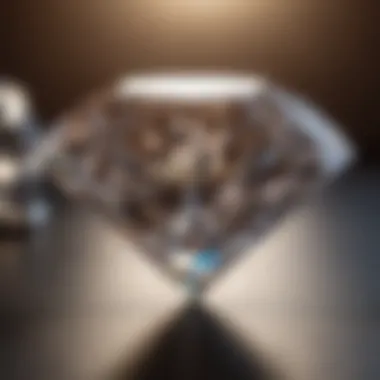
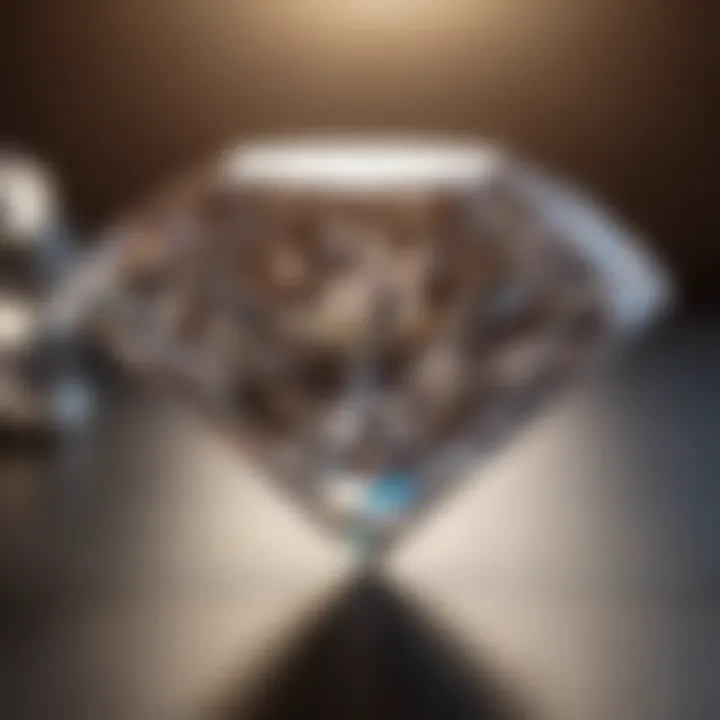
Consumer Perception of Value
Understanding consumer perception of value in diamonds is crucial for anyone involved in jewelry, whether you are a buyer, seller, or a collector. This perception shapes buying behaviors, influences investment decisions, and ultimately determines what people consider as a valuable diamond. As social beings, our relationship with commodities often hinges on both subjective interpretations and collective societal norms.
Psychological Aspects of Diamond Ownership
The psychological allure of owning a diamond is multifaceted. There’s a certain prestige wrapped around the image of a diamond, often seen as a symbol of wealth, love, and commitment. Many individuals tie the ownership of a diamond to significant life events—like engagements or anniversaries—associating it with cherished memories. This emotional connection can outweigh the objective qualities of the stone itself, as many buyers are influenced by sentiment rather than just technical specifications.
Moreover, owning a diamond often brings a sense of social status. In certain circles, having a quality diamond can elevate one’s standing, leading to perceptions that increase its value beyond mere quality.
- Social Proof: People often look to others to gauge their desires. Celebrities and influencers regularly showcase diamonds on social media, altering public perception and raising the demand for similar styles.
- Aesthetic Appreciation: The innate beauty of diamonds captures hearts and minds. Buyers don’t just see a diamond; they see brilliance and craftsmanship that resonates at a deeply personal level.
Ultimately, these psychological factors reflect back on consumer perception. The value of a diamond is not only in its physical attributes but also in how it makes the owner feel.
Trends in Consumer Preferences
As consumer habits change, so does their outlook on what constitutes a valuable diamond. In recent years, we have seen shifts fueled by various factors:
- Sustainability: More consumers are leaning towards ethical sourcing. Diamonds that come from conflict-free zones or are lab-created are rapidly gaining popularity as buyers prioritize responsible consumption.
- Personalization: There’s a growing trend for unique, customized pieces. Buyers are no longer satisfied with the standard solitaire; rather, they desire personalized shapes, cuts, and settings that align with their individuality.
- Influence of Technology: The internet has democratized access to information. Consumers are now doing their homework before purchasing, often seeking and valuing detailed information on certificates and appraisals.
"The evolution of consumer preference undeniably adds layers of complexity to how diamonds are valued."
As such, these evolving preferences don’t just reflect changing tastes but also a broader awareness of ethical, cultural, and aesthetic values. Every nuance, from design to sourcing, now finds its way into the diamond valuation conversation, challenging traditional metrics and circumstances.
With this understanding, industry players can find themselves better equipped to cater to emerging markets and shifting consumer expectations. Thus, recognizing and addressing consumer perceptions form the backbone of any successful strategy in the diamond industry.
Investment Potential of Diamonds
The investment potential of diamonds is both intricate and multi-dimensional, demanding a discerning eye and a solid grasp of market dynamics. As tangible assets, diamonds offer a unique blend of beauty and rarity. Unlike most traditional investments, they hold an emotional value that transcends mere monetary figures. Understanding this aspect is crucial for both collectors and investors aiming to navigate this fascinating arena.
There are several elements to consider regarding the investment potential of diamonds:
- Rarity and Value Appreciation: Diamonds, particularly those that are assessed as high-quality, have demonstrated a consistent trajectory of value appreciation over time. Certain unique characteristics can significantly elevate their desirability, such as distinctive colors or exceptional clarity. For instance, colored diamonds like blue or pink often fetch astronomical prices at auctions, sometimes surpassing those of their colorless counterparts.
- Market Fluctuations: Like any commodity, the diamond market is subject to fluctuations based on varying factors including economic conditions, consumer preferences, and supply chain dynamics. Being aware of trends and events—like changes in mining policies or developments in synthetic diamond technology—is vital for keeping abreast of value shifts.
- Diversification Strategies: In the realm of investments, diamonds can serve as an excellent means to diversify one’s portfolio. With traditional stocks or bonds, investors often face market volatility. Diamonds, however, have shown resilience during economic downturns, serving as a hedge against inflation. Therefore, incorporating diamonds into an investment strategy can potentially mitigate risks.
"Diamonds can be a hedge against inflation and an opportunity to diversify an investment portfolio."
As we delve deeper into why diamonds can be attractive in an investor's portfolio, we’ll examine how they serve as effective portfolio diversifiers next.
Diamonds as Portfolio Diversifiers
Diamonds possess distinctive qualities that can act as fruitful diversifiers in an investment portfolio. Their physical nature and the emotional weight they carry create a buffer against the erratic nature of financial markets. Not bound to the same factors governing stocks or bonds, diamonds can offer not only aesthetic pleasure but also a pragmatic function in investing.
- Physical Tangibility: Unlike digital assets or heavily financialized commodities, diamonds are physical objects. This tangibility can provide an investor with peace of mind, allowing them to feel more secure about the preservation of their wealth. The ability to hold a diamond, appreciate its craftsmanship, and understand its intrinsic value renders them not just investments but also cherished possessions.
- Global Demand: The global demand for diamonds continues to be robust, especially in emerging markets. Growth in nations like India and China is leading to a higher appetite for luxury goods, diamonds included. As demand continues to surge, this can bring about value optimization in the long term.
- Limited Availability: The mining process for natural diamonds is labor-intensive and limited by geographical boundaries. This scarcity helps maintain their value, unlike mass-produced items. Furthermore, these limitations create a natural inclination for prices to rise over time, especially for high-quality stones.
Risks and Rewards in Diamond Investment
In any investment endeavor, understanding the risks and rewards is a pivotal consideration. Diamonds are no exception, offering both considerable opportunities and unique challenges that savvy investors should keep in mind.
- Market Volatility: The diamond market can be oscillatory, influenced by trends, regulatory changes, and shifts in consumer sentiment. Unlike stocks that have readily available and transparent price histories, diamonds often lack standardized pricing, which can create discrepancies in investment assessments.
- Liquidity Concerns: While diamonds can be sold at significant prices, liquidity can sometimes be an issue. Unlike stocks that can be quickly traded on exchanges, diamonds usually require a market where buyers are willing to invest and negotiate. This can be problematic if an investor needs quick access to liquid capital.
- Value Recognition: Assessing the value of diamonds may also pose challenges. Without expert appraisals or certifications, one might misjudge a diamond’s worth, leading to either overpaying or underestimating the asset’s potential. As a result, investing in diamonds requires due diligence, research, and often specialized knowledge.
On the flip side, the upside potential can far outweigh these risks. Given their historical appreciation, emotional value, and position as a hedge against economic downturns, diamonds remain a fascinating option for both seasoned investors and newcomers wanting to embark on their investment journeys.
Ending: The Complex Nature of Diamond Worth
When it comes to valuing diamonds, the topic is far from straightforward. It’s a multifaceted issue that intertwines aesthetic appeal, cultural significance, market dynamics, and ethical considerations. Understanding this complexity is crucial for anyone interested — this includes gemstone enthusiasts, collectors, jewelry designers, and even those considering a diamond purchase for personal reasons.
The diamond’s worth goes well beyond the mere sparkle and clarity; it reflects decades of market evolution, personal values, and emerging global trends. The insights gathered throughout this article emphasize how diverse factors shape perceptions and valuations. By developing a nuanced understanding of these elements, individuals are better equipped to navigate the intricate world of diamonds.
Key Elements to Consider in Diamond Valuation
- Subjectivity of Value: Each diamond tells its own story, and personal preferences often dictate perceived worth. A collector might place more emphasis on historical significance, while a designer may prioritize unique cuts.
- Ethical Sourcing: In the modern context, ethical considerations can alter value. Many consumers are now looking for conflict-free diamonds, impacting demand and price.
- Market Fluctuations: The diamond market is influenced by various economic indicators, making it essential for potential investors to be aware of current trends and historical patterns in the market.
- The Role of Certification: Understanding certifications is vital. The reputability of grading reports can significantly affect a diamond's resale value.
- Investment Outlook: While diamonds can serve as sound investments, it is important to acknowledge the risks involved. The potential for appreciation exists, but so too does the threat of depreciation based on market conditions.
Ultimately, the nuanced nature of diamond worth requires a discerning eye and a careful evaluation of multiple factors. As the conversation around diamonds continues to evolve — increasingly featuring discussions about sustainability and ethical sourcing — it becomes imperative for stakeholders to stay well-informed. In doing so, they not only make better purchasing decisions but also appreciate the deeply entrenched historical and cultural narratives that these stones represent.
"The value of a diamond lies not just in its physical attributes, but also in the stories and philosophies it embodies."
This complex narrative permeates our understanding of diamonds, shedding light on why they hold such a privileged place in human culture and economy. Recognizing this complexity paves the way for more informed discussions about value, ownership, and appreciation.



